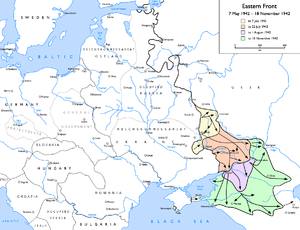Battle of Voronezh (1942)
| Battle of Voronezh (1942) | |||||||
|---|---|---|---|---|---|---|---|
| Part of World War II | |||||||
 The Eastern Front at the time of the Battle of Voronezh. (click to enlarge) |
|||||||
|
|||||||
| Belligerents | |||||||
|
|
|
||||||
| Commanders and leaders | |||||||
|
|
|
||||||
| Casualties and losses | |||||||
| 94,500 casualties including 19,000 KIA and MIA |
568,347 290,522 killed and 80,000 captured 197,825 wounded |
||||||
The Battle of Voronezh, or First Battle of Voronezh, was a battle on the Eastern Front of World War II, fought in and around the strategically important city of Voronezh on the Don river, 450 km (280 mi) south of Moscow, from 28 June-24 July 1942, as opening move of the German summer offensive in 1942.
The German attack had two objectives. One was to seed confusion about the ultimate goals of the overall campaign. There was widespread feeling by almost all observers, especially Soviet high command, that the Germans would reopen their attack on Moscow that summer. By strongly attacking toward Voronezh, near the site of the German's deepest penetration the year before, it would hide the nature of the real action taking place far to the south. Soviet forces sent to the area to shore up the defenses would not be able to move with the same speed as the Germans, who would then turn south and leave them behind. The other purpose was to provide an easily defended front line along the river, providing a strong left flank that could be protected with relatively light forces.
The plan involved forces of Army Group South, at this time far north of their ultimate area of responsibility. The attack would be spearheaded by the 4th Panzer Army under the command of General Hermann Hoth. Hoth's highly mobile forces would move rapidly eastward to Voronezh and then turn southeast to follow the Don to Stalingrad. As the 4th moved out of the city, the slower infantry forces of the Second Army following behind them would take up defensive positions along the river. The plan called for the 2nd to arrive just as the 4th had cleared the city, and Hoth was under orders to avoid any street-to-street fighting that might bog down their progress.
The city was defended by the troops of the 40th Army as part of the Valuiki-Rossosh Defensive Operation (28 June-24 July 1942) of General of Army Nikolai Fyodorovich Vatutin's Southwestern Front. Hoth's powerful armored forces moved forward with little delay and the only natural barrier before the city was the Devitsa River, an arm of the Don running through Semiluki, a short distance to the west. For reasons that are unclear, the bridge over the Devitsa was not destroyed, and Hoth's forces were able to sweep aside the defensive forces placed there and reach the outskirts of Voronezh on 7 July. Soviet forces then mounted a successful counterattack that tied up Hoth's forces.
...
Wikipedia
